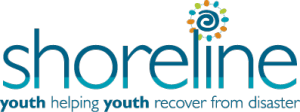A program affiliated with Colorado State University marked the two-year anniversary of Superstorm Sandy in a special way: On Oct. 29, high school students in New York City posed questions about life during and after a catastrophe to a very particular group of experts – high school students in the Gulf Coast who experienced the BP Oil Spill and lived through as many as six hurricanes in the past decade, including Hurricane Katrina in 2005.
Their youth-led rapid video project, “The Katrina/Sandy Youth Dialogue, Part 1,” is a product of the SHOREline program, a national youth-empowerment project developed at Columbia University’s National Center for Disaster Preparedness at the Earth Institute and at the Center for Disaster and Risk Analysis at Colorado State University.
‘Kind of scared’
“How did you feel during Hurricane Katrina?” one of the sophomores from New York City’s Urban Assembly School for Emergency Management (UASEM) asked his counterparts in the SHOREline program at Alma Bryant High School in South Mobile County, Alabama.
“I was kind of scared,” admitted the Bryant junior. “I remember hearing the house next door to us being blown away, and we were afraid it was going to tear our house apart.”
 All of the students are part of SHOREline, a school-based curricular and extracurricular program where “youth help youth recover from disaster.” SHOREline is embedded in participating high schools as either a curricular or extracurricular program staffed by a high school teacher, in which the students focus on Skills, Hope, Opportunities, Recovery and Engagement. The SHOREline curriculum centers on project-based learning, where the teens identify problems and develop their own solutions to the issues in their communities.
All of the students are part of SHOREline, a school-based curricular and extracurricular program where “youth help youth recover from disaster.” SHOREline is embedded in participating high schools as either a curricular or extracurricular program staffed by a high school teacher, in which the students focus on Skills, Hope, Opportunities, Recovery and Engagement. The SHOREline curriculum centers on project-based learning, where the teens identify problems and develop their own solutions to the issues in their communities.
The questions
For this particular youth dialogue project, ninth and tenth graders at NYC’s UASEM, a new public high school dedicated to training the next generation of emergency management professionals, developed a set of questions about hurricane response and recovery to ask their peers in Gulf Coast high schools in Louisiana, Mississippi and Alabama. Among the questions they asked were: “What were the obstacles that your community faced in the aftermath of Katrina? Did you find the media portrayal of Hurricane Katrina accurate? Were there any recovery programs put in place for those who needed assistance both mentally and physically?”
With the help of documentary filmmaker and educator Philip B. Swift, the SHOREline students used smartphones and cameras to record their questions and answers. Students at Benjamin Franklin High School (New Orleans, La.), South Lafourche High School (Cut Off, La.), Thibodaux High School (Thibodaux, La.), Gulfport High School (Gulfport, Miss.), and Alma Bryant High School (Irvington, Ala.) responded to the questions of their fellow NYC SHOREliners.
‘Powerful connections’
According to SHOREline Co-director David Abramson, “One of our objectives with SHOREline is to help the students make powerful connections. This video dialogue project exemplifies how the students use media to foster relationships outside their home community while learning about the broader impacts of disasters.”
Co-director Lori Peek, an associate professor in CSU’s Department of Sociology, concurred: “We developed this program in response to needs and desires expressed by the teens in disaster-affected communities. They have taken the lead in developing tools and resources to help each other and youth in other communities who might be exposed to disasters. It is so powerful for the students who have experienced such disasters to realize that they have something valuable to share with others, and that they can make a difference.”
For further information about SHOREline, see the project’s website at www.shoreline.ncdp.columbia.edu, or contact Abramson at dma3@columbia.edu or Peek at lori.peek@colostate.edu.